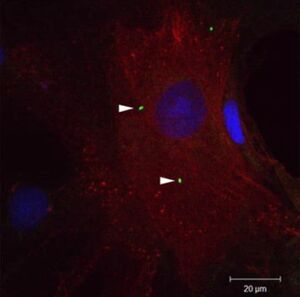Brucella pinnipedialis
Classification
Bacteria; Proteobacteria; Alphaproteobacteria; Hyphomicrobiales; Brucellaceae; Brucella/Ochrobactrum group
Species
|
NCBI: [1] |
Brucella pinnipedialis
Description and Significance
Brucella pinnipedialis was isolated in 1994 after being discovered in stranded harbor seals (Phoca vitulina). This organism has since been found in pinnipeds (i.e., seals, sea lions, walruses), with research done mostly on harbor seals and hooded seals (Cystophora cristata) (Nymo et al. 2011; Lambourn et al. 2013; Larsen et al. 2013; Larsen et al. 2016; Rhyan et al. 2018).
A related but separate strain, Brucella ceti, has been isolated from cetaceans, including harbor porpoises, common, striped, and bottlenose dolphins. B. ceti is known to be pathogenic, forming lesions and causing abortions in cetaceans. Less is known about the pathogenic capabilities of B. pinnipedialis, making it a species of concern due to its association with stranded harbor seals and the possibility of transmittance to humans (Nymo et al. 2011; Audic et al. 2011).
Genome Structure
B. pinnipedialis genome has been sequenced (Audic et al. 2011; Orsini et al. 2022) and consists of two circular chromosomes that contain 3,342 protein coding genes. One chromosome consists of 2,138,342 base pairs and the other consists of 1,260,926 base pairs (Audic et al. 2011). The core genome consists of 2998 genes. Several of their genes code for antimicrobial resistance, including gyrA (nalidixic acid resistance) and mprF (cationic peptide resistance). The genes within B. pinnipedialis code for things like membrane transport, carbohydrate, lipid, and amino acid metabolism, neurodegenerative, cardiovascular, and endocrine disease, drug resistance, and viral and bacterial infectious disease (Orsini et al. 2022).
Cell Structure, Metabolism and Life Cycle
Like other Brucella species, Brucella pinnipedialis is a small, non-motile, coccobacillary gram-negative bacteria. Its ability to live both within and without a host classifies it as a facultative intracellular bacterium. (Nymo et al. 2011). Research has revealed that Brucella species found in marine mammals are aerobic, nitrate reducing, catalase-, oxidase-, and urease-positive, and are unable to ferment carbohydrates (Foster et al. 2007).
Ecology and Pathogenesis
B. pinnipedialis was originally isolated from marine mammals in Scottish waters but has since been isolated in other parts of the Atlantic and Pacific oceans, as well as the Mediterranean Sea (Whatmore et al. 2017).
Brucella species are theorized to be transmitted several ways, including ingestion, breathing it in, open wounds coming in contact with the strain, during breeding/lactation, etc (Nymo et al. 2011). Transmittance most likely occurs during ingestion. Rhyan et al. (2018) propose that B. pinnipedialis lives in a nematode (Parafilaroides sp.) that serves as a vector to spread B. pinnipedialis. The nematode that lives in the seals lungs eventually dies and gets coughed up, which is when B. pinnipedialis enters the seals digestive system and explains why strains are found in seal feces (Rhyan et al. 2018). While there is no data to suggest B. pinnipedialis prefers one sex over the other, younger harbor seals (pups through subadults) were found to be infected at a higher rate (Lambourn et al. 2013)
Brucella infections have been associated with a decline of successful pups during pupping season, but other pathogenic symptoms observed in infected seals have been limited (Nymo et al. 2011). B. pinnipedialis is known, however, to cause disease in domestic animals, such as cattle and other ruminants (Lambourn et al. 2013). Symptoms include abortions, premature births, and epididymitis (Nymo et al. 2011).
References
Audic S, Lescot M, Claverie JM, Cloeckaert A, & Zygmunt MS. 2011. The genome sequence of Brucella pinnipedialis B2/94 sheds light on the evolutionary history of the genus Brucella. BMC Evolutionary Biology. 11(200). https://doi.org/10.1186/1471-2148-11-200
Foster G, Osterman BS, Godfroid J, Jacques I, & Cloeckaert A. 2007. Brucella ceti sp. nov. and Brucella pinnipedialis sp. nov. for Brucella strains with cetaceans and seals as their preferred hosts. International Journal of Systematic and Evolutionary Microbiology. 57(11): 2688–2693. https://doi.org/10.1099/ijs.0.65269-0
Lambourn DM, Garner M, Ewalt D, Raverty S, Sidor I, Jeffries SJ, Rhyan J, & Gaydos JK. 2013. Brucella pinnipedialis infections in Pacific harbor seals (Phoca vitulina richardsi) from Washington state, USA. Journal of Wildlife Diseases. 49(4): 802-815. https://doi.org/10.7589/2012-05-137
Larsen AK, Nymo IH, Briquemont B, Sørensen KK, & Godfroid J. 2013. Entrance and survival of Brucella pinnipedialis hooded seal strain in human macrophages and epithelial cells. PLOS ONE 8(12): e84861. https://doi.org/10.1371/journal.pone.0084861
Larsen AK, Godfroid J, & Nymo IH. 2016. Brucella pinnipedialis in hooded seal (Cystophora cristata) primary epithelial cells. Acta Veterinaria Scandinavica. 59(9). https://doi.org/10.1186/s13028-016-0188-5
Nymo IH, Tryland M, & Godfroid J. 2011. A review of Brucella infection in marine mammals, with special emphasis on Brucella pinnipedialis in the hooded seal (Cystophora cristata). Veterinary Research. 42(93). https://doi.org/10.1186/1297-9716-42-93
Orsini M., Ianni A., Zinzula L. 2022. Brucella ceti and Brucella pinnipedialis genome characterization unveils genetic features that highlight their zoonotic potential. MicrobiologyOpen. 11(5). https://doi.org/10.1002/mbo3.1329
Rhyan J, Garner M, Spraker T, Lambourn D, & Cheville N. 2018. Brucella pinnipedialis in lungworms Parafilaroides sp. and Pacific harbor seals Phoca vitulina richardsi: proposed pathogenesis. Diseases of Aquatic Organisms. 131: 87-94. 8 https://doi.org/10.3354/dao03291
Whatmore AM, Dawson C, Muchowski J, Perrett LL, Stubberfield E, Koylass M, Foster G, Davison NJ, Quance C, Sidor IF, Field CL, & St. Leger J. Characterisation of North American Brucella isolates from marine mammals. 2017. PLOS ONE. 12(9). https://doi.org/10.1371/journal.pone.0184758
Author
Page authored by Abigail Flowers, student of Prof. Bradley Tolar at UNC Wilmington.

